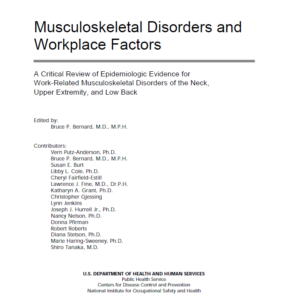 Musculoskeletal Disorders and Workplace Factors
Musculoskeletal Disorders and Workplace Factors
Download PDF of “Musculoskeletal Disorders and Workplace Factors”
Musculoskeletal disorders (MSDs) are injuries or disorders that affect the muscles, tendons, ligaments, nerves, or other soft tissues of the body. MSDs can cause pain, stiffness, numbness, tingling, or reduced function in the affected areas. MSDs are common among workers who perform tasks that involve physical factors such as force, repetition, posture, or vibration. Some examples of MSDs are neck pain, shoulder tendinitis, carpal tunnel syndrome, and low back pain.
NIOSH Review Findings
The National Institute for Occupational Safety and Health (NIOSH) has conducted a critical review of the epidemiologic evidence for work-related MSDs of the neck, upper extremity, and low back . The review summarizes the scientific literature on the relationship between MSDs and workplace factors. For instance, job design, work organization, and psychosocial factors. The review also evaluates the quality and strength of the evidence. To clarify, it identifies gaps in knowledge, and provides recommendations for future research and prevention.
The main findings of the review are:
- There is a large body of credible epidemiologic research that shows a consistent relationship between MSDs and certain physical factors, especially at higher exposure levels.
- The evidence is strongest for work-related MSDs of the hand/wrist, followed by the shoulder and the elbow. The evidence is less consistent for work-related MSDs of the neck and the low back.
- There is limited evidence for the role of individual factors, such as age, gender, and anthropometry, in modifying the risk of MSDs. There is also limited evidence for the role of psychosocial factors, such as job satisfaction, job stress, and social support, in influencing the occurrence or severity of MSDs.
- There is a need for more research on the dose-response relationship between physical factors and MSDs, the interaction between physical and psychosocial factors, the effectiveness of ergonomic interventions in reducing MSDs, and the cost-benefit analysis of ergonomic programs.
Things to Remember
The review provides useful information for employers, workers, health professionals, and researchers who are interested in preventing work-related MSDs. The review also highlights the importance of ergonomics in designing tasks, work spaces, controls, displays, tools, lighting, and equipment to fit workers’ physical capabilities and limitations.
You can read the full review online or download it as a PDF file . You can also find more information about ergonomics and MSDs on the NIOSH website.
